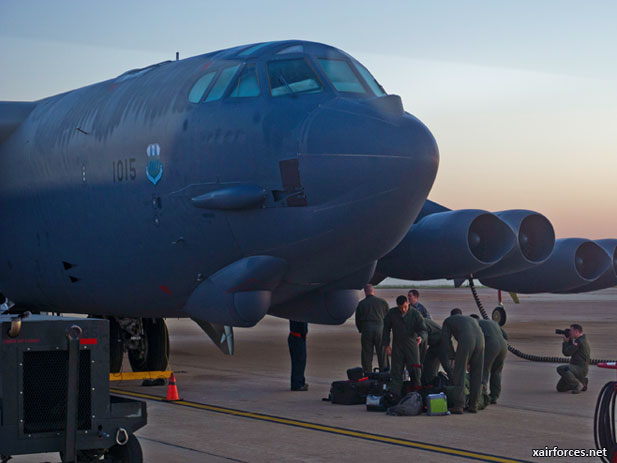
Global Strike Command Leader Previews B-52 Upgrades

During a recent visit to Edwards AFB, Calif., the commander of Air Force Global Strike Command spent time with B-52 Combined Test Force officials to preview the combat capability enhancements made to the B-52H Stratofortress.
During a recent visit to Edwards AFB, Calif., the commander of Air Force Global Strike Command spent time with B-52 Combined Test Force officials to preview the combat capability enhancements made to the B-52H Stratofortress.
Modernizing and sustaining the nation's long range strike aviation capability is a top priority for the command, Lt. Gen. Jim Kowalski said, who recently noted the B-52 has served and delivered decisive effects in many recent U.S. conflicts to include Operation Iraqi Freedom.
We're celebrating this year as the Year of the B-52, marking both the 50th anniversary of the last delivery of a B-52H to Minot AFB, N.D., and the 60th anniversary of the first test flight of the YB-52, he said.
He attributed the reliability and combat capability of the dual-role bomber to the talented maintenance personnel, outstanding depot support and the Air Force's continued investment in the airframe.
The B-52H is a dual-capable aircraft designed to carry a variety of weapons in support of a range of military operations. It has been projected for a number of upgrades that have already been made to the two B-52H test aircraft at Edwards AFB.
These upgrades are integral to ensuring the B-52H is both effective and able to fully integrate with other services, as envisioned in the Air Sea Battle concept, according to command officials.
Among the upgrades is a guided "smart weapon" capability in the B-52H's internal weapons bay, which provides a 66 percent increase in guided weapons payload. Another current program is an upgrade to the latest Advanced Targeting Pod, which will increase the B-52H effectiveness when performing close air support and other missions.
One of the test aircraft at Edwards AFB also featured an improved on-board communications upgrade called Combat Network Communications Technology (CONECT).
The CONECT program brings the B-52H from the analog into the digital age, according to command officials, providing an invaluable data link over which to pass mission and threat data.
With the new defense strategy placing a greater emphasis on the Pacific, it's really important that our bombers are fully networked and integrated with the joint force, Kowalski said.
The command provides a fleet of B-52Hs and a cadre of Airmen from Minot AFB and Barksdale AFB year-round in support of the continuous bomber presence mission in the Pacific, which ensures stability and peace in the region.
"Long-range, payload, persistence ... these three attributes underlie key capabilities provided by Global Strike Command's B-2 and B-52H fleet," said Col. Rick Mitchell, the Bomber Requirements Division chief. "These attributes become increasingly important to combat the 'tyranny of distance' posed by the vast expanse of the Pacific Ocean.
"Integrating a beyond line-of-sight data link and installing new controls and color displays on the aircraft decreases the crew workload significantly," Mitchell said "A controlling agency can now send mission updates to the B-52 via the data link without having to rely on voice communications.
"Because the data link is integrated with the aircraft offensive avionics system, the aircrew simply has to accept the mission change which is then automatically loaded into the avionics and weapons," he continued. "Our current and temporary datalink solution does not provide us with this capability. The ability of CONECT to accomplish this retargeting allows for standoff weapons survivability and shorten the close air support kill chain."
These digital enhancements will ensure the viability of the B-52H well into the 21st century, Mitchell said.
Source: BARKSDALE AIR FORCE BASE, La. - US Air Force; issued May 12, 2012
Photo: BARKSDALE AIR FORCE BASE, La. - B-52H Stratofortress crew members from the 96th Bomb Squadron, Barksdale Air Force Base, La., begin to board for a training flight, April 18. The training allows the air crew to practice numerous capabilities for the B-52H, including nuclear and conventional missions, rapid global strike capabilities and the ability to reach hardened targets anytime, anywhere. (U.S. Air Force photo/Senior Airman Marleah Miller) (Photo by afgsc.af.mil)
(20.05.2012)
|